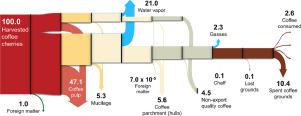Resources, Conservation and Recycling ( IF 11.2 ) Pub Date : 2021-03-31 , DOI: 10.1016/j.resconrec.2021.105554 Neil M. Rotta , Stephen Curry , Juliet Han , Rommel Reconco , Edward Spang , William Ristenpart , Irwin R. Donis-González

|
Although coffee is one of the most valuable and widely traded agricultural commodity in the world (US$83 billion in 2017 revenue), little information exists in the scientific literature regarding coffee bean postharvest processing. In particular, sustainability analyses require information on the coffee bean mass and property changes during processing, from harvest to final consumption. In this study, a detailed analysis of the washed or wet-processed method for coffee postharvest processing is provided. Mass flow data were collected through site visits, surveys, laboratory measurements, and interviews with coffee wet and dry mill operators in several countries throughout Central America and Mexico, as well as roasters and cafés in the United States, to establish representative mass flow rates and process flow diagrams from harvest to cup. Results indicate that 100 kg of harvested coffee cherries will on average yield 2.6 kg of mass consumed by humans as exported coffee, equivalent to approximately 839 metric cups (250 ml) of drip brew coffee or 897 metric shots (30 ml) of espresso. The remaining 97.4 kg provide opportunities for development of alternative products, and other economic uses. Importantly, the data suggests that more mass is lost during depulping in practice than previously indicated by laboratory measurements. This study provides a foundation for further investigations in the fields of equipment improvement, byproduct utilization, and environmental and economic sustainability of the coffee processing and distribution chain.
中文翻译:

对咖啡洗净后的加工过程中的操作和质量流的综合分析
尽管咖啡是世界上最有价值和交易最广泛的农产品之一(2017年收入为830亿美元),但科学文献中几乎没有有关咖啡豆收获后加工的信息。特别是,可持续性分析需要有关从收获到最终消费的加工过程中咖啡豆质量和特性变化的信息。在这项研究中,提供了咖啡收获后加工的洗涤或湿法处理方法的详细分析。质量流量数据是通过现场访问,调查,实验室测量以及对中美洲和墨西哥几个国家的咖啡干湿磨机操作员以及美国烘焙商和咖啡馆的访谈收集的,以确定代表性的质量流量和从收获到杯子的工艺流程图。结果表明,收获的100千克樱桃咖啡平均可产出2.6千克人类作为出口咖啡而消耗的质量,相当于大约839公升杯(250毫升)滴注咖啡或897公升装(30毫升)浓缩咖啡。剩余的97.4公斤为替代产品的开发和其他经济用途提供了机会。重要的是,这些数据表明,在实践中,除浆过程中损失的质量比实验室测量先前所表明的要多。这项研究为进一步研究设备改进,副产品利用以及咖啡加工和分销链的环境和经济可持续性领域提供了基础。相当于大约839公尺杯(250毫升)滴水冲泡咖啡或897公尺量(30毫升)浓缩咖啡。剩余的97.4公斤为替代产品的开发和其他经济用途提供了机会。重要的是,这些数据表明,在实践中,除浆过程中损失的质量比实验室测量先前所表明的要多。这项研究为进一步研究设备改进,副产品利用以及咖啡加工和分销链的环境和经济可持续性领域提供了基础。大约相当于839公尺杯(250毫升)滴水冲泡咖啡或897公尺量(30毫升)意式浓缩咖啡。剩余的97.4公斤为替代产品的开发和其他经济用途提供了机会。重要的是,这些数据表明,在实践中,除浆过程中损失的质量比实验室测量先前所表明的要多。这项研究为进一步研究设备改进,副产品利用以及咖啡加工和分销链的环境和经济可持续性领域提供了基础。数据表明,实际除浆过程中损失的质量比实验室测量先前所表明的要多。这项研究为进一步研究设备改进,副产品利用以及咖啡加工和分销链的环境和经济可持续性领域提供了基础。数据表明,实际除浆过程中损失的质量比实验室测量先前所表明的要多。这项研究为进一步研究设备改进,副产品利用以及咖啡加工和分销链的环境和经济可持续性领域提供了基础。









































 京公网安备 11010802027423号
京公网安备 11010802027423号